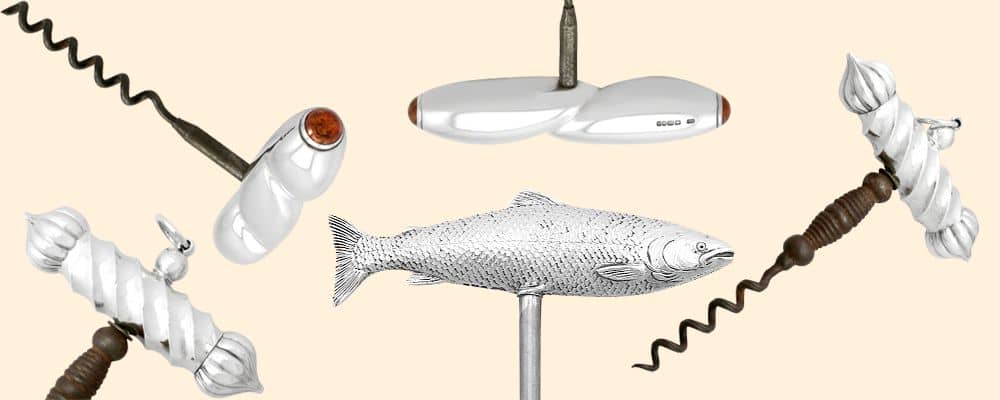Antique Corkscrews
Silver Corkscrews for Sale
Explore our fine collection of antique and vintage silver corkscrews and bottle openers for sale. Our collection includes silver corkscrews from many eras including Victorian examples through to more contemporary times.
All corkscrew purchases will arrive with a complementary insurance valuation and will include free global shipping.
Andrew Campbell, using his 40 years’ experience within the antique silver industry, handpicks all silverware for sale.

Antique Corkscrews Frequently Asked Questions
A corkscrew is a tool that was invented to draw corks from wine, beer, and other bottles before the invention of screw caps.
The form of the corkscrew is simple, consisting of a pointed metallic helix attached to a handle. Corks are typically small and smooth, and as such are difficult to remove from inflexible- and breakable- bottles. To retrieve a cork from a bottle using a corkscrew, the user would simply screw the helix into it until it was firmly embedded, then pull to extract.
References to corkscrews have been noted as early as the 1680s, although they were then dubbed ‘steel worms’. These instruments were variations on the ‘gun worm’, a tool that soldiers used to clean their musket barrels.
Corkscrews were made from the late 1600s, but specimens from this time are difficult to find. Most examples of corkscrews that collectors have interest in are dated to the last 25 years of the 18th century, and were largely made in Germany.
Many sheath-type corkscrew cases were made entirely of silver, although some were made with ivory, inlaid with silver and gold.
Most corkscrews of this kind are about 3 inches long, however tiny examples were also made featuring silver screws. Originally used for removing the corks from perfume bottles, they are highly valued, and sometimes found in ladies travelling dressing cases.
Especially rare 18th century examples of full-size corkscrews also featured nutmeg graters.
Generally, 18th century examples survive in fairly excellent condition, the silver being sturdy enough to remain in good shape. The tip of the iron screw, however, may be damaged so late into its life.
Most large 19th century corkscrews were made of brass and iron, though some had silver mounts. It should be noted, however, that this was a very rare occurrence. These examples are undoubtedly the finest – and this most valuable – corkscrews on the collector’s market today.
The first patented corkscrew was established in 1795 in a collaboration between Reverend Samuel Henshall and Birmingham manufacturer Matthew Boulton. Their key improvement on the traditional corkscrew design was the addition of a concave disk between the handle and the ‘worm’. The purpose of this button was to compress and turn the cork once the helix was fully inserted, thus breaking the seal between the glass neck of the bottle and the cork. This design was so effective that it was widely used for over 100 years.
'Waiter's Friend' Corkscrew
A waiter’s friend, sommelier knife, or wine key corkscrew was conceived in 1882 by Karl Wienke. This slim, foldable, corkscrew is in a folding body similar to that of a pocket knife. It utilises a screw and a single lever, due to an arm that uses the body of the bottle for leverage to ease the upwards pull of the cork. Whilst this style was patented in Germany, America and England, the Dutch are renowned for their quality silver pocket corkscrews.
Winged Corkscrew
This style was invented by Domenick Rosati in 1930, and afterwards utilised by multiple brands to accommodate the growth in popularity of the wine market. The winged corkscrew has multiple aliases:
Cork-extractor
Owl corkscrew
Butterfly corkscrew
Angel corkscrew
This form has two levers which rise as the worm is embedded into the cork. Pushing down the levers allows the cork to be retrieved from the bottle in one smooth motion. This form is especially effective when crafted out of heavier, thicker metals such as silver.
Lever Corkscrew
The lever (or ‘rabbit’) corkscrew is operated using a pair of handles which grip the neck of the bottle. A lever is pressed down to twist the screw into the cork and then lifted to extract it. Whilst this style of corkscrew is often rather expensive, it is far more efficient than other styles.
The lever (or ‘rabbit’) corkscrew is operated using a pair of handles which grip the neck of the bottle. A lever is pressed down to twist the screw into the cork and then lifted to extract it. Whilst this style of corkscrew is often rather expensive, it is far more efficient than other styles.





